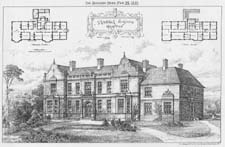Robert Hammond
Founder of the Hampton School
c1487-1557
Robert Hammond or Hamonde of Hampton is best known for being the founder of Hampton School. He was the eldest son of a West Molesey yeoman who died in 1501. His father, John, was descended from a Suffolk family of Hamondes. John Hammond who died and was buried in West Molesey in 1501 left Isobel, his second wife, and four children named Robert, John, Elizabeth and Johanne or Joan. Robert, the eldest, was probably not more than fourteen at the time.
Little is known of his early career, although he was established in a prosperous way as a London brewer by 1523 when he was described as 'berebruer and woodmonger'. He had supplied beer, at various times, under Cardinal Wolsey's orders to the continent for use of the King's Army and Navy.

Property in Hampton
By 1529 he was already the lessee of land in Hampton parish held by the Monastery of Isleworth Syon, near Twickenham. In 1536 he acquired two acres of land and a building of some kind in Hampton. Although his principal interests were in the brewing business in London he had certainly taken up residence, at least part time, in Hampton by 1540 and was indeed the largest tax payer. He also had a house in Kingston and was at one time “bailiff” (the principal municipal officer) of that place.
The Founder of Hampton School
Robert made his will on 7 March 1556/7 and he died and was buried on 19 April 1557 in Hampton in spite of a provision in his will that he should be buried in Kingston church. His will was proved on 15 Jun 1557. He was a wealthy man and his will lists properties in many places, as well as various bequests. He left money to set up a school in Kingston and another in Hampton. He can therefore claim to be the initiator of Kingston Grammar School to whom his heirs paid money for 21 years to set up and run the school, as well as Hampton where money was also left for the same purpose in perpetuity.
Robert Hammond left a free tenement (The Bell Inn) and one acre of land and other housing to found a “free scoole to be kepte in the seid village (Hampton) for euer”. The provisions of the will meant that small building “with seates in yt” was to be erected in the churchyard within three years. The vicar of Hampton and his successors were to teach the children of the village for an annual sum of three pounds, derived from the rents of property that had been left for the purpose. In the meantime the children were to be taught, probably, within the church building.

The School closed for some years
Although Hampton School was thereby founded in 1557 there was provision in the will that the school would only continue as long as the vicar, churchwardens and parishioners carried out his requests. If not, then the properties would revert to his heirs. It seems that the school (in its first incarnation) did not survive beyond 1568 and possibly earlier and the properties reverted to the heirs.
Subsequently, however, the school was to be re-opened in 1612. This was as a result of a Commission that was established to enquire into the fate of Tudor charities that had disappeared for various reasons in different parts of the country. The “learned counsell on bothe sides” reached a deadlock at the Commissioners. However in the spirit of compromise and through the generosity of the then legal owner of the properties, Nicholas Pigeon, the school was re-endowed. The school has continued in various forms and in various buildings ever since.
Further Reading:
Bernard Garside, The History of Hampton School from 1556 to 1700, 1931
Bernard Garside, A brief history of Hampton school 1557-1957, 1957
Bernard Garside, The free school of Robert Hammond in Hampton-on-Thames and other




